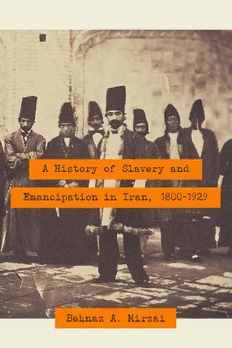
A history of slavery and emancipation in Iran, 1800-1929 PDF
Preview A history of slavery and emancipation in Iran, 1800-1929
A History of slAvery And emAncipAtion in irAn, 1800–1929 THIS PAGE INTENTIONALLY LEFT BLANK A History of Slavery and Emancipation in Iran, 1800–1929 BeHnAz A. mirzAi University of texas Press Austin Copyright © 2017 by the University of Texas Press All rights reserved Printed in the United States of America First edition, 2017 Requests for permission to reproduce material from this work should be sent to: Permissions University of Texas Press P.O. Box 7819 Austin, TX 78713- 7819 http://utpress.utexas.edu/rp- form ♾ The paper used in this book meets the minimum requirements of Ansi/niso z39.48- 1992 (r1997) (Permanence of Paper). liBrAry of congress cA tAloging- in- puBlicA tion dAtA Names: Mirzai, Behnaz A., author. Title: A history of slavery and emancipation in Iran, 1800/1929/ Behnaz A. Mirzai. Description: First edition. | Austin : University of Texas Press, 2017. | Includes bibliographical references and index. Identifiers: lccn 2016024726 | isBn 9781477311752 (cloth : alk. paper) | isBn 9781477311868 (pbk. : alk. paper) | isBn 9781477311875 (library e- book) | isBn 9781477311882 (non- library e- book) Subjects: lcsH: Slavery—Iran—History. | Slave trade—Iran—History. | Blacks— Iran—History. | Slaves—Emancipation—Iran—History. | Iran—History. Classification: lcc Ht1286 .m57 2017 | ddc 306.3/620955—dc23 lc record available at https://lccn.loc.gov/2016024726 doi:10.7560/311752 to my sons BeHrouz And rouzBeH in memory of my fAtHer, mAHmoud THIS PAGE INTENTIONALLY LEFT BLANK contents A Note to the Reader ix Acknowledgments xi Introduction 1 cHApter one. Commerce and Slavery on Iran’s Frontiers, 1600–1800: An Overview 26 cHApter two. Slavery and Forging New Iranian Frontiers, 1800–1900 35 cHApter tHree. The Trade in Enslaved People from Africa to Iran, 1800–1900 53 cHApter four. Patterns of Enslavement 74 cHApter five. Slaves in Nineteenth- Century Iran 91 cHApter six. Slave-Trade Suppression Legislation 131 cHApter seven. Antislavery Debates Within Iran 159 cHApter eigHt. Emancipation 180 Final Thoughts 206 Glossary 215 Notes 217 Bibliography 291 Index 315 THIS PAGE INTENTIONALLY LEFT BLANK A note to tHe reAder in tHe Hopes of explaining the transformations of the slavery system in Iran not only to academic specialists in Iranian history, but also of reaching an audience unfamiliar with the history of Iran and literature on slavery in the Middle East, I have avoided the use of specialized jargon. My aim is to maintain the spellings of names exactly as they appear in ar- chival sources in the endnotes unless there is a major discrepancy, in which case I employ the correct modern spelling. transliteration In this book, I have used the transliteration system of the International Journal of Middle East Studies for Persian, Arabic, and Turkish words. translations Translations of all foreign sources (Persian, Arabic, Turkish, and French) are mine. Dates Dates in this book are written in the Gregorian style. In endnotes, the dates of English sources are Gregorian, Persian documents of sAm and books are cited in Hijri Shamsi (modern Iranian or solar calendar), and Persian docu- ments of vuK are Hijri Qamari (Islamic or lunar calendar) unless noted Sh. (Hijri Shamsi). Units of MeasUre weigHts Man is an Iranian unit of weight equal to 3 kg. Ray is an Iranian unit of weight equal to 11.87 kg.1 currency It is impossible to determine the exact value of coins used in Iran. The most common coin in circulation was the toman. Some coins were minted in Iran while others were foreign. The exchange in every province and city differed
